Exploring the Spatial Determinants of Rural Poverty in the Interprovincial Border Areas of the Loess Plateau in China: A Village-Level Analysis Using Geographically Weighted Regression
Abstract
1. Introduction
2. Literature Review
2.1. Understanding Poverty
2.2. Poverty Measurement and Mapping
2.3. Geographical Environment and Poverty
3. Methodology and Data
3.1. Study Area
3.2. Methodology
3.2.1. Socioeconomic Accessibility
3.2.2. Global Spatial Autocorrelation
3.2.3. Geographically Weighted Regression Model
3.3. Variable Selection and Data Source
4. Spatial Patterns of Rural Poverty
5. Spatial Determinants of Rural Poverty
5.1. Ordinary Least Squares (OLS) Analysis
5.2. GWR Analysis
5.2.1. Socioeconomic Accessibility
5.2.2. Water Resource Accessibility
5.2.3. Land Resources
5.2.4. Topography
6. Policy Implications and Conclusions
Author Contributions
Funding
Acknowledgments
Conflicts of Interest
References
- Liu, Y.; Guo, Y.; Zhou, Y. Poverty alleviation in rural China: Policy changes, future challenges and policy implications. China Agric. Econ. Rev. 2018, 10, 241–259. [Google Scholar] [CrossRef]
- UNDP. Transform our World:2030 Agenda for Sustainable Development; United Nations: New York, NY, USA, 2016. [Google Scholar]
- UNDP. The Millennium Development Goals Report; United Nations: New York, NY, USA, 2015. [Google Scholar]
- Liu, Y.; Xu, Y. A geographic identification of multidimensional poverty in rural China under the framework of sustainable livelihoods analysis. Appl. Geogr. 2016, 73, 62–76. [Google Scholar] [CrossRef]
- Liu, Y.; Li, J. Geographic detection and optimizing decision of the differentiation mechanism of rural poverty in China. Acta Geogr. Sin. 2017, 72, 161–173. [Google Scholar]
- Xu, J.; Song, J.; Li, B.; Liu, D.; Wei, D.; Cao, X. Do settlements isolation and land use changes affect poverty? Evidence from a mountainous province of China. J. Rural Stud. 2020. [Google Scholar] [CrossRef]
- Ding, J.; Zhiming, L. Regional poverty analysis in a view of geography science. Acta Geogr. Sin. 2018, 73, 232–247. [Google Scholar]
- Zhou, Y.; Liu, Y. The geography of poverty: Review and research prospects. J. Rural Stud. 2019. [Google Scholar] [CrossRef]
- Li, Y.; Cao, Z.; Zheng, X.; Liu, Y. Regional and Sustainable Approach for Target-Poverty Alleviation and Development of China. Bull. Chin. Acad. Sci. 2016, 31, 279–287. [Google Scholar]
- Wen, Q.; Shi, L.; Ma, C.; Wang, Y. Spatial heterogeneity of multidimensional poverty at the village level: Loess Plateau. Acta Geogr. Sin. 2018, 73, 1850–1864. [Google Scholar]
- Cao, X.; Xu, J. Spatial heterogeneity analysis of regional economic development and driving factors in China’s provincial border counties. Acta Geogr. Sin. 2018, 73, 1065–1075. [Google Scholar]
- Fotheringham, A.; Charlton, M. Geographically Weighted Regression: The Analysis of Spatially Varying Relationships; Wiley: New York, NY, USA, 2002. [Google Scholar]
- Liu, X.; Li, Y.; Wang, Y.; Guo, Z.; Zheng, F. Geographical identification of spatial poverty at county scale. Acta Geogr. Sin. 2017, 72, 545–557. [Google Scholar]
- Sen, A. Well being, agency and freedom: The dewey lectures. J. Philos. 1985, 82, 169–221. [Google Scholar]
- Bank, W. World Development Report; Oxford University Press: New Work, NY, USA, 1981. [Google Scholar]
- Bourguignon, F.; Chakravarty, S. The Measurement of Multidimensional Poverty. J. Econ. Inequal. 2003, 1, 25–49. [Google Scholar] [CrossRef]
- UNDP. Human Development Report 2010: The Real Wealth of Nations: Pathways to Human Development; Palgrave Macmillan: New York, NY, USA, 2010. [Google Scholar]
- Bird, K.; Shepherd, A.J.W.D. Livelihoods and Chronic Poverty in Semi-Arid Zimbabwe. World Dev. 2003, 31, 591–610. [Google Scholar] [CrossRef]
- Foster, J.E. Absolute versus Relative Poverty. Am. Econ. Rev. 1998, 88, 335–341. [Google Scholar]
- Milbourne, P. The Geographies of Poverty and Welfare. Geogr. Compass 2010, 4, 158–171. [Google Scholar] [CrossRef]
- Amato, P.R.; Zuo, J. RURAL POVERTY, URBAN POVERTY, AND PSYCHOLOGICAL WELL-BEING. Sociol. Q. 1992, 33, 229–240. [Google Scholar] [CrossRef]
- Liu, Y.; Li, Y. Revitalize the world’s countryside. Nature 2017, 548, 275–277. [Google Scholar] [CrossRef]
- Alkire, S.; Foster, J. Counting and Multidimensional Poverty Measurement. J. Public Econ. 2011, 95, 476–487. [Google Scholar] [CrossRef]
- Wagle, U. Rethinking poverty: Definition and measurement. Int. Soc. Sci. J. 2002, 54, 155–165. [Google Scholar] [CrossRef]
- Elbers, C.; Lanjouw, J.O.; Lanjouw, P. Micro–Level Estimation of Poverty and Inequality. Econometrica 2003, 71, 355–364. [Google Scholar] [CrossRef]
- Esteban, M.D.; Morales, D.; Pérez, A.; Santamaría, L. Small area estimation of poverty proportions under area-level time models. Comput. Stat. Data Anal. 2012, 56, 2840–2855. [Google Scholar] [CrossRef]
- Pratesi, M.; Giusti, C.; Marchetti, S. Small Area Estimation of Poverty Indicators. In Survey Data Collection and Integration; Davino, C., Fabbris, L., Eds.; Springer: Berlin/Heidelberg, Germany, 2013; pp. 89–101. [Google Scholar] [CrossRef]
- Feng, Z.; Wang, S.; Jin, S.; Yang, J. Effects of urban morphology and wind conditions on land surface temperature in Changchun. Acta Geogr. Sin. 2019, 74, 902–911. [Google Scholar]
- Edward, P.; Sumner, A. Estimating the Scale and Geography of Global Poverty Now and in the Future: How Much Difference Do Method and Assumptions Make? World Dev. 2014, 58, 67–82. [Google Scholar] [CrossRef]
- Erenstein, O.; Hellin, J.; Chandna, P. Poverty mapping based on livelihood assets: A meso-level application in the Indo-Gangetic Plains, India. Appl. Geogr. 2010, 30, 112–125. [Google Scholar] [CrossRef]
- Minot, N.; Baulch, B. Poverty Mapping with Aggregate Census Data: What is the Loss in Precision? Rev. Dev. Econ. 2005, 9, 5–24. [Google Scholar] [CrossRef]
- Blumenstock, J.; Cadamuro, G.; On, R. Predicting poverty and wealth from mobile phone metadata. Science 2015, 350, 1073–1076. [Google Scholar] [CrossRef] [PubMed]
- Min, B.; Gaba, K.M.; Sarr, O.F.; Agalassou, A. Detection of rural electrification in Africa using DMSP-OLS night lights imagery. Int. J. Remote Sens. 2013, 34, 8118–8141. [Google Scholar] [CrossRef]
- Marchetti, S.; Beresewicz, M.; Salvati, N.; Szymkowiak, M.; Wawrowski, Ł. The use of a three-level M-quantile model to map poverty at local administrative unit 1 in Poland. J. R. Stat. Soc. Ser. A Stat. Soc. 2018, 181, 1077–1104. [Google Scholar] [CrossRef]
- Jalan, J.; Ravallion, M. Geographic poverty traps? A micro model of consumption growth in rural China. J. Appl. Econ. 2002, 17, 329–346. [Google Scholar] [CrossRef]
- Kraay, A.; Mckenzie, D. Do Poverty Traps Exist? Assessing the Evidence. J. Econ. Perspect. 2014, 28, 127–148. [Google Scholar] [CrossRef]
- Bigman, D.; Dercon, S.; Guillaume, D.; Lambotte, M. Community Targeting for Poverty Reduction in Burkina Faso. World Bank Econ. Rev. 2000, 14, 167–193. [Google Scholar] [CrossRef][Green Version]
- Liu, Y.; Liu, J.; Zhou, Y. Spatio-temporal patterns of rural poverty in China and targeted poverty alleviation strategies. J. Rural Stud. 2017, 52, 66–75. [Google Scholar] [CrossRef]
- Okwi, P.O.; Ndeng’e, G.; Kristjanson, P.; Arunga, M.; Notenbaert, A.; Omolo, A.; Henninger, N.; Benson, T.; Kariuki, P.; Owuor, J. Spatial determinants of poverty in rural Kenya. Proc. Natl. Acad. Sci. USA 2007, 104, 16769–16774. [Google Scholar] [CrossRef] [PubMed]
- Glauben, T.; Herzfeld, T.; Rozelle, S.; Wang, X. Persistent Poverty in Rural China: Where, Why, and How to Escape? World Dev. 2012, 40, 784–795. [Google Scholar] [CrossRef]
- Liu, Y.; Yang, Z.; Jilai, L. Regional differentiation characteristics of rural poverty and targeted poverty alleviation strategy in China. Bull. Chin. Acad. Sci. 2016, 269–278. [Google Scholar]
- Partridge, M.D.; Rickman, D.S. Distance from Urban Agglomeration Economies and Rural Poverty. J. Reg. Sci. 2008, 48, 285–310. [Google Scholar] [CrossRef]
- Epprecht, M.; Müller, D.; Minot, N. How remote are Vietnam’s ethnic minorities? An analysis of spatial patterns of poverty and inequality. Ann. Reg. Sci. 2011, 46, 349–368. [Google Scholar] [CrossRef]
- Zhou, L.; Xiong, L.; Wang, Y.; Zhou, X.; Yang, L. Spatial Distribution of Poverty-Stricken Counties in China and Their Natural Topographic Characteristics and Controlling Effects. Econ. Geogr. 2017, 37, 157–166. [Google Scholar]
- Guo, Y.; Yang, Z.; Zhi, C. Geographical patterns and anti-poverty targeting post-2020 in China. J. Geogr. Sci. 2018, 28, 1810–1824. [Google Scholar]
- HCPG. Huining Yearbook; People’s Publishing House of Gansu Province: Huining, China, 2018. [Google Scholar]
- HCBS. Huining Statistics Yearbook; Huining County Bureau of Statistics: Huining, China, 2017. [Google Scholar]
- Ahlström, A.; Pilesjö, P.; Lindberg, J. Improved accessibility modeling and its relation to poverty–A case study in Southern Sri Lanka. Habitat Int. 2011, 35, 316–326. [Google Scholar] [CrossRef]
- Gutiérrez, J. Location, economic potential and daily accessibility: An analysis of the accessibility impact of the high-speed line Madrid–Barcelona–French border. J. Transp. Geogr. 2001, 9, 229–242. [Google Scholar] [CrossRef]
- Geurs, K.T.; van Wee, B. Accessibility evaluation of land-use and transport strategies: Review and research directions. J. Transp. Geogr. 2004, 12, 127–140. [Google Scholar] [CrossRef]
- Yang, W.; Chen, B.Y.; Cao, X.; Li, T.; Li, P. The spatial characteristics and influencing factors of modal accessibility gaps: A case study for Guangzhou, China. J. Transp. Geogr. 2017, 60, 21–32. [Google Scholar] [CrossRef]
- Jiao, J.; Wang, J.; Jin, F.; Dunford, M. Impacts on accessibility of China’s present and future HSR network. J. Transp. Geogr. 2014, 40, 123–132. [Google Scholar] [CrossRef]
- Li, T.; Zhang, S.; Cao, X.; Witlox, F. Does a circular high-speed rail network promote efficiency and spatial equity in transport accessibility? Evidence from Hainan Island, China. Transp. Plan. Technol. 2018, 41, 779–795. [Google Scholar] [CrossRef]
- Dziauddin, M.F.; Powe, N.; Alvanides, S. Estimating the Effects of Light Rail Transit (LRT) System on Residential Property Values Using Geographically Weighted Regression (GWR). Appl. Spat. Anal. Policy 2015, 8, 1–25. [Google Scholar] [CrossRef]
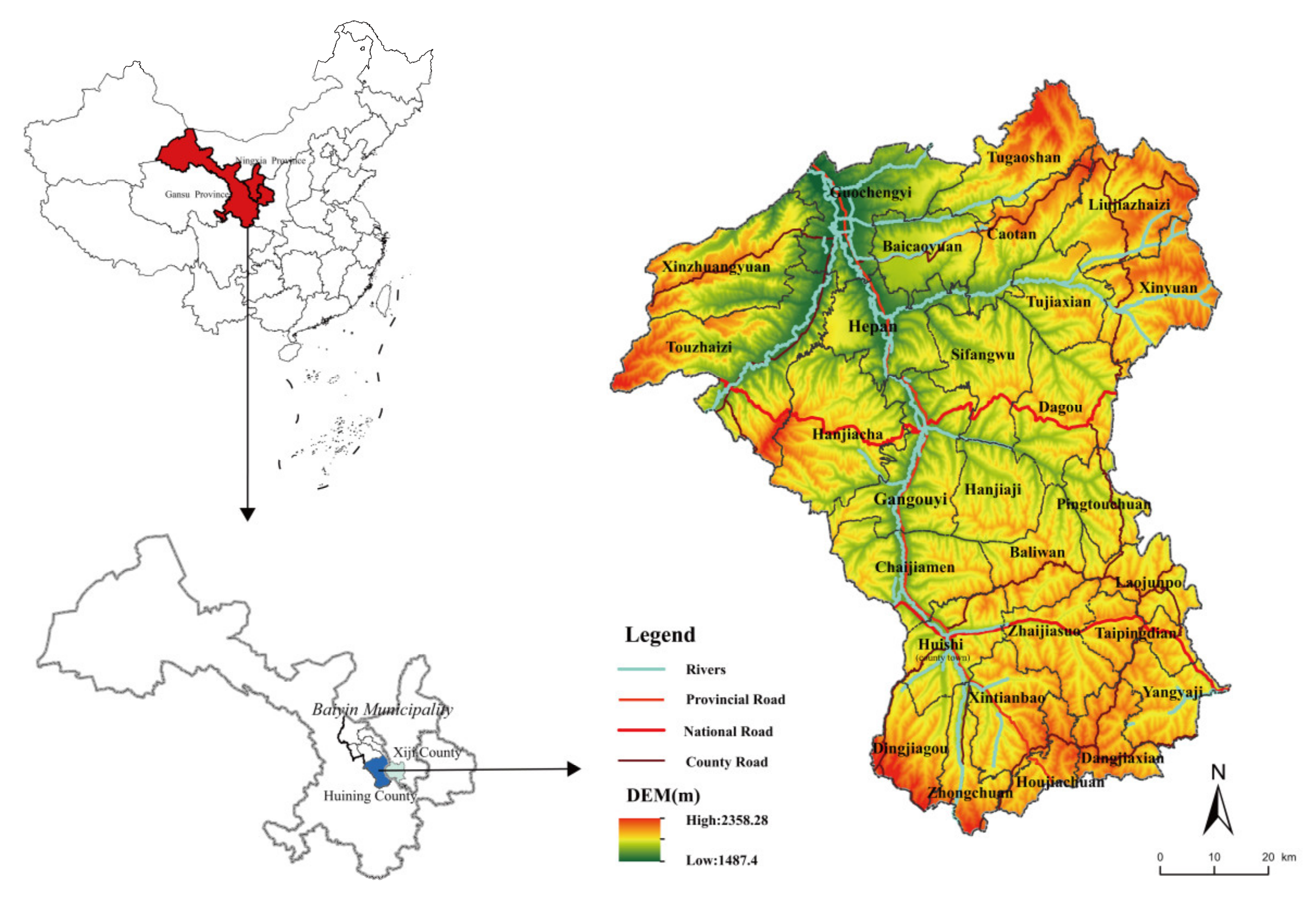

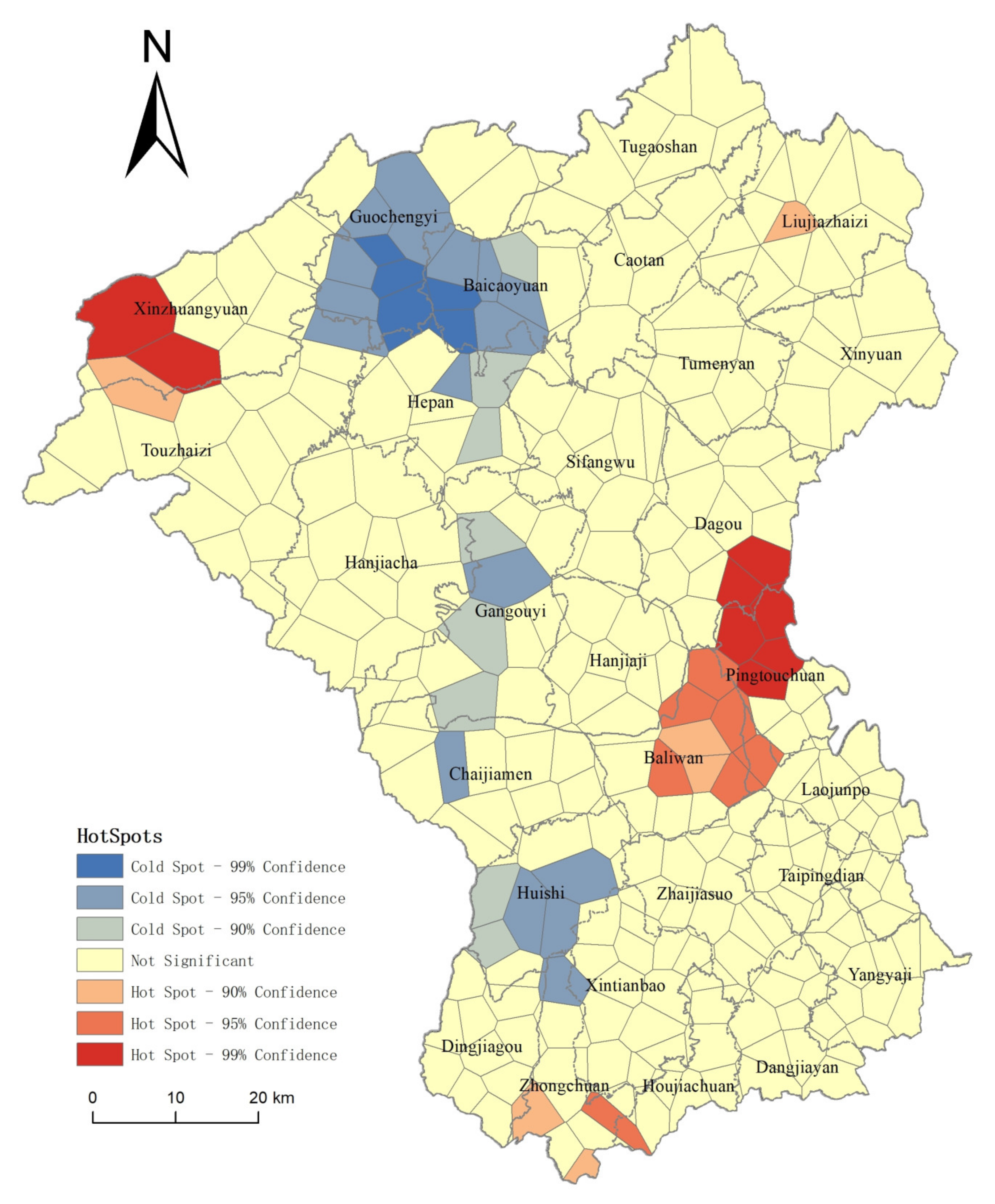
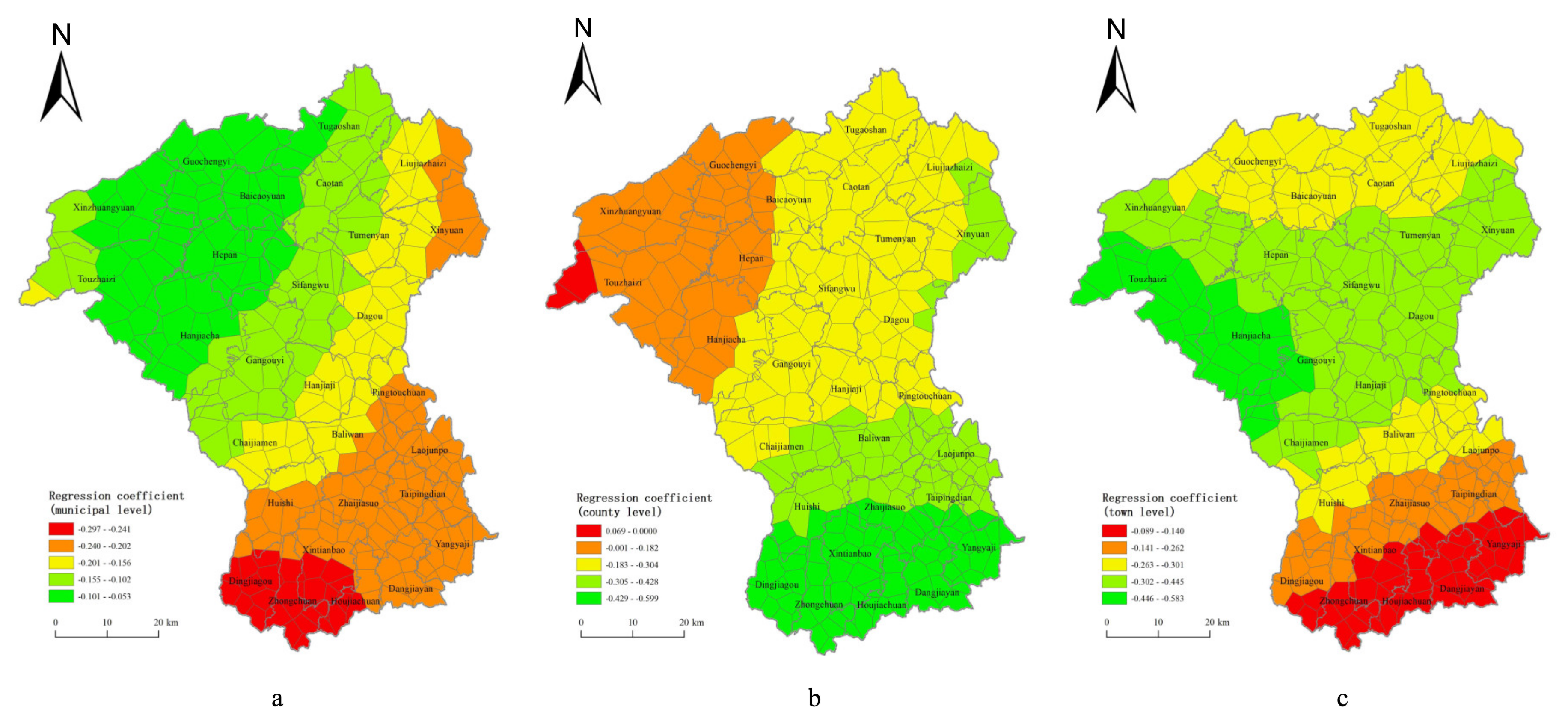
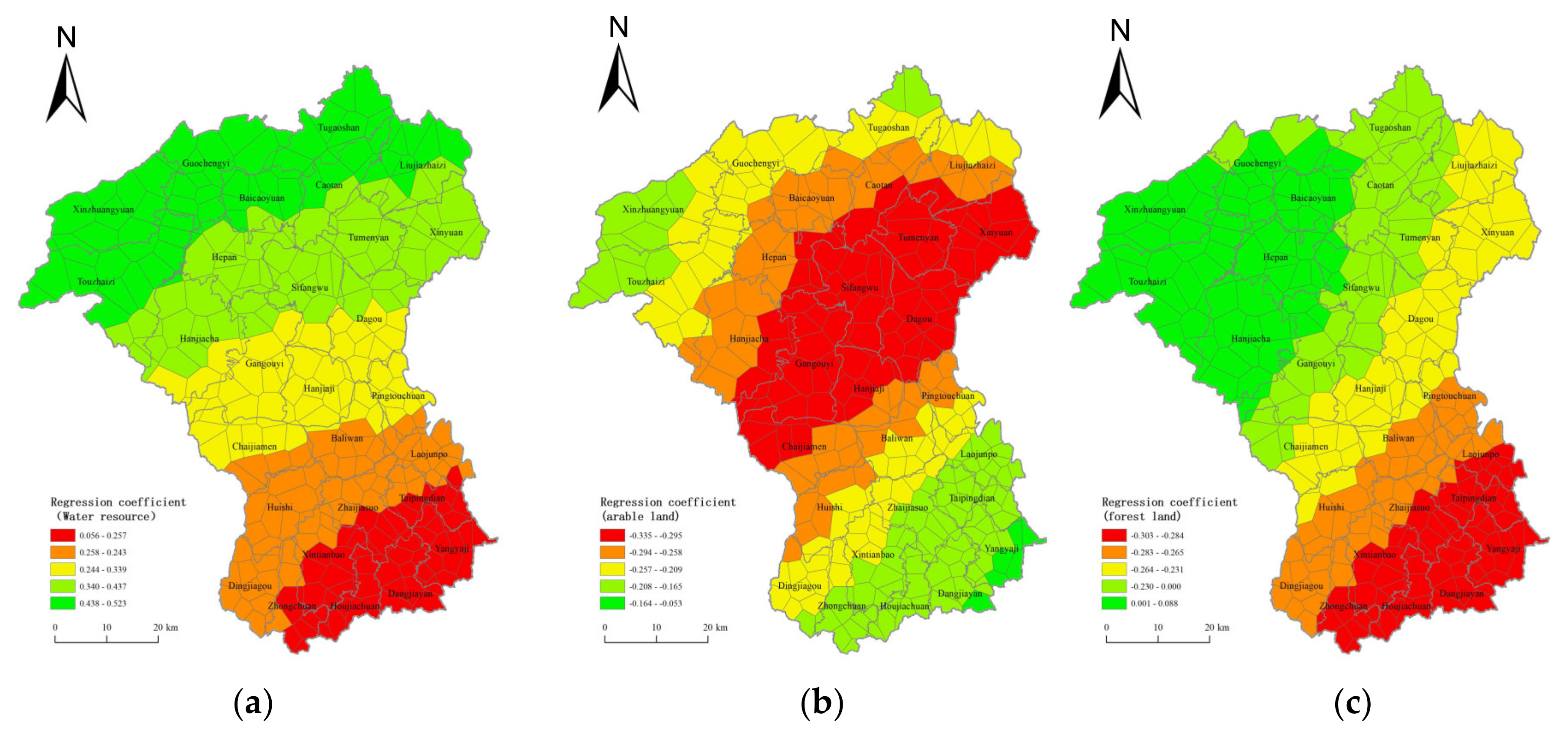
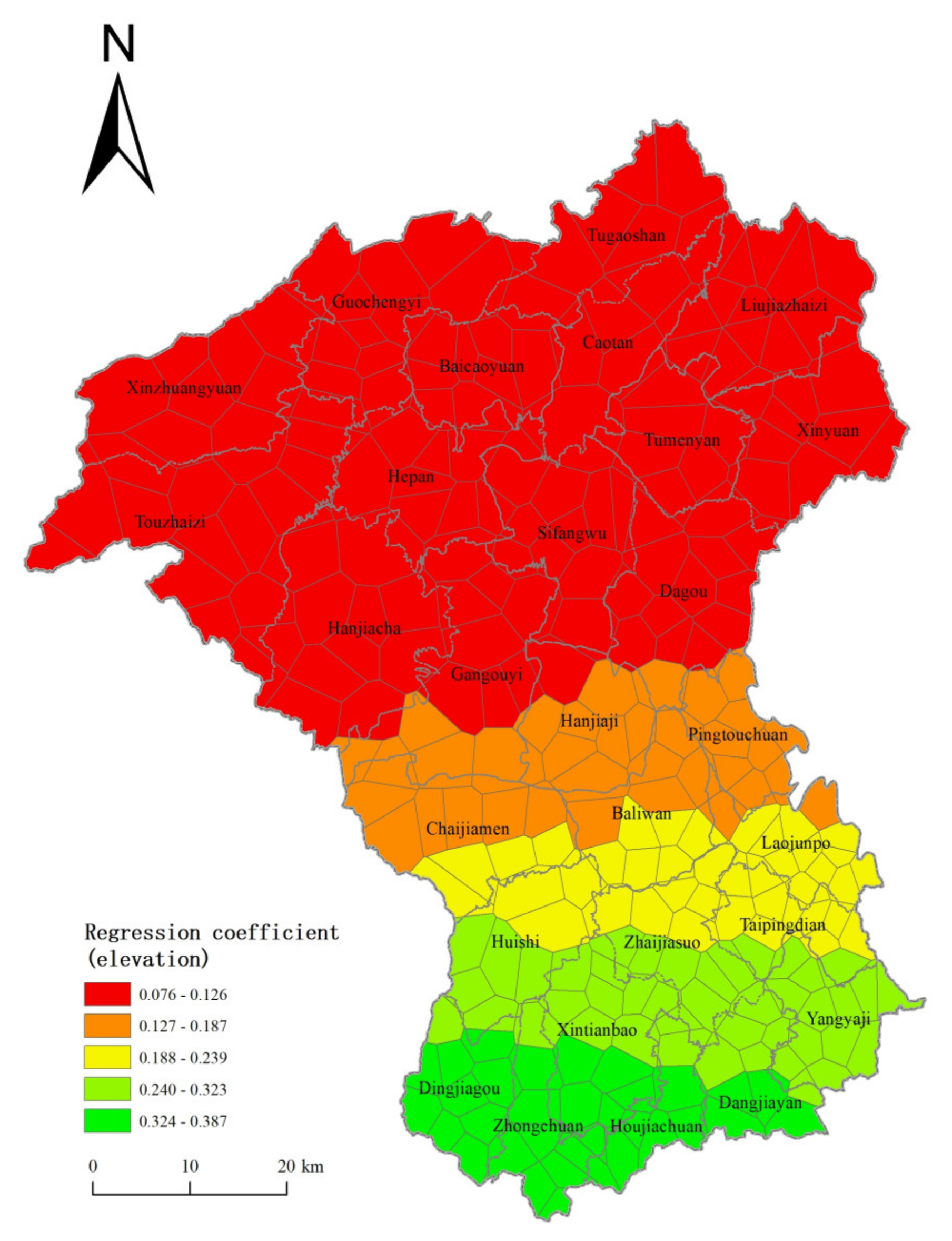
| Type | Explanatory Variable | Description | Expected Relationship with Poverty | |
|---|---|---|---|---|
| Exogenous variables | Topography | Elevation | Mean village elevation * | Positive correlation |
| Slope | Mean village slope | Positive correlation | ||
| Soil resources | Soil type | Proportion of village area with alluvial soils | Not known | |
| Proportion of village area with loessal soils | ||||
| Proportion of village area with calcareous soils | ||||
| Proportion of village area with loam soils | ||||
| Land resources | Land use | Proportion of village area with arable land * | Not known | |
| Proportion of village area with forestland * | ||||
| Proportion of village area with grassland | ||||
| Water resources | Water resource accessibility | Distance to the nearest river * | Positive correlation | |
| Endogenous variables | Socioeconomic resources | Socioeconomic accessibility | Highest accessibility value to the prefecture-level city *, county town *, and town * | Positive or negative |
| Coefficient | Std. Error | t Statistics | VIF | |
|---|---|---|---|---|
| Intercept | 0.367 | 0.016 | 22.610 | — |
| Proportion of village area with arable land | –0.183 * | 0.017 | –1.339 | 1.066 |
| Proportion of village area with forestland | –0.166 * | 0.017 | –0.924 | 1.150 |
| Average village elevation | 0.229 ** | 0.018 | 2.961 | 1.250 |
| Water resource accessibility | 0.231 ** | 0.016 | 1.780 | 1.087 |
| Municipal-level accessibility | –0.163 * | 0.019 | 1.274 | 1.394 |
| County-level accessibility | –0.239 ** | 0.017 | 2.907 | 1.064 |
| Town-level accessibility | –0.249 ** | 0.019 | 2.087 | 1.317 |
| R2 | 0.486 | |||
| Adjusted R2 | 0.469 | |||
| AIC | 76.813 | |||
| Koenker (BP) statistic | 35.368 |
| Minimum | 25% Quantile | Median | 75% Quantile | Maximum | |
|---|---|---|---|---|---|
| Intercept | 0.361 | 0.368 | 0.276 | 0.386 | 0.396 |
| Proportion of village area with arable land | −0.335 | −0.129 | −0.221 | −0.113 | −0.053 |
| Proportion of village area with forestland | −0.303 | −0.134 | −0.217 | −0.101 | 0.088 |
| Average village elevation | 0.076 | 0.113 | 0.333 | 0.194 | 0.387 |
| Distance to nearest river | 0.056 | 0.140 | 0.352 | 0.176 | 0.523 |
| Municipal-level accessibility | −0.297 | −0.174 | −0.200 | −0.138 | −0.053 |
| County-level accessibility | −0.599 | −0.286 | −0.398 | −0.209 | 0.069 |
| Town-level accessibility | −0.583 | −0.257 | −0.374 | −0.201 | −0.089 |
| R2 | 0.583 | ||||
| Adjusted R2 | 0.564 | ||||
| AIC | 69.805 | ||||
| Bandwidth | 38,335.705 |
© 2020 by the authors. Licensee MDPI, Basel, Switzerland. This article is an open access article distributed under the terms and conditions of the Creative Commons Attribution (CC BY) license (http://creativecommons.org/licenses/by/4.0/).
Share and Cite
Li, T.; Cao, X.; Qiu, M.; Li, Y. Exploring the Spatial Determinants of Rural Poverty in the Interprovincial Border Areas of the Loess Plateau in China: A Village-Level Analysis Using Geographically Weighted Regression. ISPRS Int. J. Geo-Inf. 2020, 9, 345. https://doi.org/10.3390/ijgi9060345
Li T, Cao X, Qiu M, Li Y. Exploring the Spatial Determinants of Rural Poverty in the Interprovincial Border Areas of the Loess Plateau in China: A Village-Level Analysis Using Geographically Weighted Regression. ISPRS International Journal of Geo-Information. 2020; 9(6):345. https://doi.org/10.3390/ijgi9060345
Chicago/Turabian StyleLi, Tao, Xiaoshu Cao, Menglong Qiu, and Yu Li. 2020. "Exploring the Spatial Determinants of Rural Poverty in the Interprovincial Border Areas of the Loess Plateau in China: A Village-Level Analysis Using Geographically Weighted Regression" ISPRS International Journal of Geo-Information 9, no. 6: 345. https://doi.org/10.3390/ijgi9060345
APA StyleLi, T., Cao, X., Qiu, M., & Li, Y. (2020). Exploring the Spatial Determinants of Rural Poverty in the Interprovincial Border Areas of the Loess Plateau in China: A Village-Level Analysis Using Geographically Weighted Regression. ISPRS International Journal of Geo-Information, 9(6), 345. https://doi.org/10.3390/ijgi9060345





